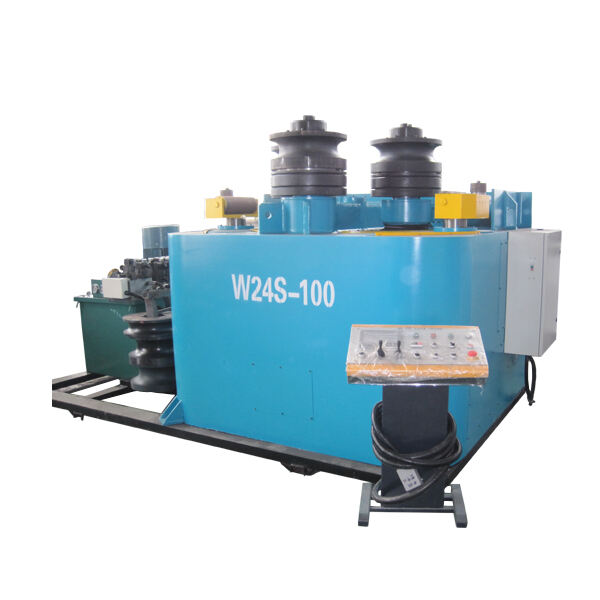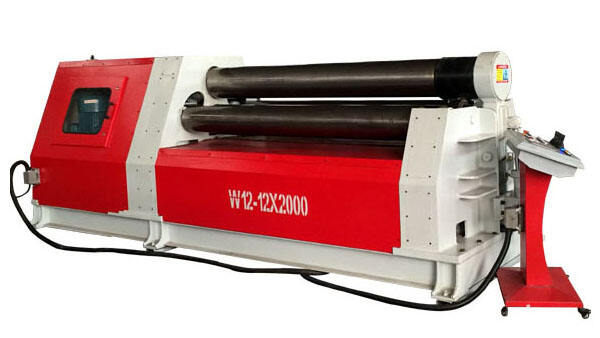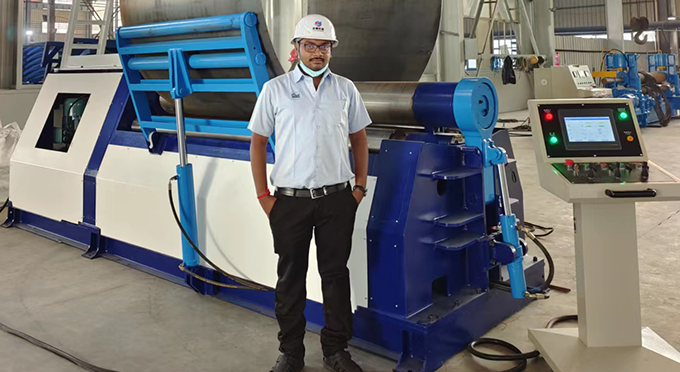Core Functionality and Design of Plate Bending Machines
What Defines a Plate Bending Machine and Its Primary Applications
Plate bending machines are basically heavy duty tools used to form flat sheets of steel into shapes like cylinders or cones by applying controlled pressure. Industries that need to bend thick materials often rely on these machines. Think about places like pressure vessel factories, shipyards, or anywhere pipelines for oil and gas get built. Most standard models can handle plates around 40 mm thick which allows for creating those smooth, accurate curves needed in larger projects. This makes them pretty much indispensable when precision matters most in construction work.
Key Operational Principles Behind Plate Bending Machine Functionality
These machines operate on the three-point bending principle, using hydraulic or electric-powered rollers to induce plastic deformation. Upper and lower rollers work together to gradually shape the material while minimizing stress concentrations. Advanced models integrate CNC-guided asymmetry correction to counteract springback, achieving bend angle tolerances within ±0.5°.
Common Configurations: 2-Roll, 3-Roll, and 4-Roll Plate Bending Machines
- 2-Roll Systems: Feature a driven bottom roll and adjustable top roll, ideal for rapid production of uniform cylinders. However, they cannot pre-bend plate edges, limiting end usability.
- 3-Roll Symmetric: Use one top roll and two bottom rolls for bidirectional bending, offering improved throughput for medium-complexity shapes.
- 4-Roll Asymmetric: Include an additional side roll to eliminate flat zones at plate ends, enabling 98% material utilization—crucial for precision aerospace components.
Material Thickness Capacity and Force Requirements in Plate Bending
The amount of force needed for bending goes up dramatically as materials get thicker and stronger. Take a 30mm carbon steel plate for instance, which generally needs around 12,000 kN per meter to shape properly. To handle these demands, most manufacturers tweak their equipment settings, adjusting roll diameters between 250 and 800 mm while making sure frames are sturdy enough to avoid bending under pressure during work with those tough HSLA steels. These days many shops have started using smart control systems too. They rely on sensors that provide instant feedback so machines can automatically fine tune applied forces as needed. According to recent findings published in MetalForming Journal back in 2023, this approach cuts down waste significantly, bringing down scrap rates by about 18 percent overall.
Roll Bending Machines: Structure and Operational Mechanisms
Defining Roll Bending Machines and Their Role in Metal Forming
Sheet metal workers rely on roll bending machines to shape various materials by passing them through carefully positioned rollers. These machines create all sorts of curved parts ranging from simple pipes to complex tank shapes and even architectural elements. What sets roll benders apart from standard plate benders is their ability to handle different material thicknesses without losing quality. They can work with delicate 1.5mm stainless steel just as easily as they tackle 40mm thick aluminum sections. This versatility makes them indispensable in workshops where projects require everything from lightweight panels to substantial structural components.
Three-Roll vs Four-Roll Designs: Structural Differences and Implications
Three roll systems work well for simple curves thanks to their triangular arrangement of rollers. However these setups need constant manual adjustment when trying to form complete cylinders which can be quite time consuming. Moving on to four roll configurations adds an extra roller on the side that stops materials from slipping during processing. This design allows for much tighter control over dimensions around plus or minus 0.1 millimeters per meter length. For industries like aerospace manufacturing where precision is absolutely critical, this makes all the difference. According to findings published in MDPI last year, switching to four roll technology cuts down those pesky springback errors by about a quarter compared to traditional methods because the forces applied across the material are distributed far better throughout the forming process.
Single-Pinch vs Double-Pinch Configurations and Their Efficiency Trade-Offs
Single-pinch systems use one powered roll, offering cost-effective performance with moderate cycle rates (8–12 cycles/hour). Double-pinch models employ two driven rolls, doubling grip strength for hardened or asymmetrical materials. While these reduce setup time by 40%, they consume 18% more energy per cycle—a key consideration in energy-efficient fabrication strategies.
Impact of Roll Design on Processing Accuracy and Surface Quality
The shape of rolling tools has a major impact on both surface quality and dimensional accuracy in metal forming processes. When working with thin sheets, crowned rollers help stop those annoying edge waves from forming. For thicker sections, grooved rolls provide better grip during bending operations, which makes all the difference when dealing with stubborn metals. CNC polished rollers with a surface roughness around 0.4 microns or less dramatically reduce scratches on finished parts compared to regular polished surfaces we typically see. Many shops report seeing up to 90% fewer marks after switching. In pipe manufacturing specifically, going from traditional three roll systems to balanced four roll configurations boosts roundness measurements by approximately 31% for big diameter pipes. This matters because even small deviations can cause problems downstream in applications where tight tolerances are required.
Comparative Analysis: Geometry, Movement, and Output Capabilities
Machine Geometry and Deformation Control in Plate vs Roll Bending
Most plate bending machines work with symmetrical setups using either three or four rolls to spread out stress evenly over large sheet metal pieces. When it comes to roll benders, things get a bit different as they usually go for an asymmetrical layout. A single main roll does most of the heavy lifting here, applying focused pressure that works really well for creating those tight radius bends. Controlling how materials deform is another key difference between these two types of equipment. Plate benders tackle springback issues through balanced hydraulic power that can reach around 12,000 kN of force. Roll benders take a different approach altogether. They make repeated small adjustments based on what sensors tell them about material thickness changes. Modern systems now offer pretty impressive accuracy levels too, measuring within plus or minus half a millimeter during operation.
Roll Movement Mechanisms: Precision and Flexibility in 3-Roll and 4-Roll Systems
The four roll machine design includes a passive bottom roll that lets operators adjust both X and Y axes at the same time. This cuts down on setup time by roughly 30 to 40 percent compared with three roll versions. When working with delicate materials such as titanium grade 5 alloy, this kind of dual axis control really matters because standard movement methods can actually scratch or mar surfaces during processing. The American Welding Society reported last year that these four roll systems manage ovality in round components about 15 percentage points better than their three roll counterparts do.
Shape Versatility: Cylinders, Cones, Flanges, and Complex Profiles
Standard roll benders work best for regular cylindrical shapes where the diameter is about 120 times thicker than the wall itself. When it comes to making cone shapes though, plate benders are the go to choice, especially for those big energy sector jobs that need angles between 60 and 90 degrees. The newer computer controlled versions can actually manage multiple radius bends by adjusting their tilt settings together, getting pretty close to within quarter degree accuracy on flange work. Some shops have started mixing these two approaches in hybrid setups, which allows them to create complex curved shapes with surprisingly tight radii sometimes just 1.5 times the material thickness when working with ASTM A36 steel.
Performance Comparison: Accuracy, Efficiency, and Application Suitability
Precision and Repeatability in Plate Bending Machine Outputs
Modern plate bending machines can achieve around 0.5 degree angular accuracy for heavy steel work, thanks to their solid frame construction that holds up even when dealing with weights over 2,500 tons. What makes them so reliable is the consistent operation of their hydraulic systems combined with properly aligned rolls throughout the process. According to recent research published last year, these machines showed impressive results too - maintaining about 98.7 percent consistency in dimensions after completing 100 consecutive bends on 50mm thick ASTM A36 steel plates. This kind of performance matters a lot in industrial settings where precision counts.
Setup Time and Cycle Efficiency in Roll Bending Operations
Roll bending machines complete setups 30–45% faster than plate benders, leveraging pre-programmed CNC profiles for common pipe diameters (6″–96″). Continuous rolling enables 15–20 cycles/hour in stainless steel tube production, nearly double the output of plate systems. However, roll benders require 25% more recalibration when switching between cone and cylinder geometries.
Debunking the Myth: Are 4-Roll Machines Always Better Than 3-Roll?
Four roll systems do cut down on material handling time, around 18% according to some research from ScienceDirect back in 2024. But when it comes to bending those heavy wall pipes over an inch thick, three roll machines still hold their own better. Looking at actual field results, three roll units tend to keep ovality below 1.2 mm even with 24 inch schedule 80 pipes. The four roll versions typically end up around 1.8 mm instead. So what works best really depends on what needs doing. For mass production of thinner walls under half an inch thick, go with four rolls. But if precision matters most for those thicker walls, stick with three roll technology where accuracy counts.
Real-World Applications and Future Trends in Bending Technology
When to use a plate bending machine for heavy-duty industrial fabrication
When it comes to working with thick materials, plate bending machines really shine, handling steel plates as thick as 150 mm according to recent industry data from the Industrial Fabrication Report in 2023. These machines have become the go to solution across several key industries including shipbuilding, structural steel fabrication, and manufacturing pressure vessels where both strength and accuracy matter most when dealing with ASTM A36 or stainless steel grades. What sets these machines apart is their remarkable capability to maintain an angular tolerance under half a degree even on plates stretching eight meters long. This level of precision isn't just impressive technically speaking it's actually critical for constructing reliable bridges and stable offshore platforms that need to withstand extreme conditions over time.
Ideal use cases for roll bending machines in cylindrical and conical forming
Roll bending machines work really well for making those long curves needed in things like pipelines, big storage tanks, and various architectural components. What makes them stand out is how they apply force evenly across the material, which helps prevent stress points from forming during fabrication processes. This matters a lot when working on parts for airplane bodies or industrial drums used in food processing plants. Some research in the aerospace field actually showed that these machines cut down on wasted materials by around 22 percent compared to older segmented techniques, especially good results were seen with thinner gauge metals ranging from about 0.8mm all the way up to 12mm thick.
Advancements in CNC, smart sensors, and adaptive control systems
Today's advanced systems come equipped with AI that handles deflection compensation automatically, adjusting for springback based on live data from strain gauges. The new hybrid machines that do both plate and roll bending are cutting down setup time quite a bit actually about 40% less time when working on prototypes. Facilities that connect their CNC equipment to the cloud can now select dies remotely and calibrate forces without being onsite. This makes things run smoother especially in places with ISO certification where they often handle several projects at once across different departments.
FAQ Section
What is the main difference between plate bending and roll bending machines?
Plate bending machines are primarily used to form flat sheets into shapes like cylinders or cones, often for thicker materials, using a controlled pressure system. Roll bending machines specialize in shaping various materials into curved parts, piping, or tanks and can handle varying material thicknesses with high versatility.
Can roll benders handle thick materials like plate benders?
Yes, roll benders can work on thick materials; however, they particularly excel in situations requiring precision and flexibility with different thickness levels, making them ideal for pipes and conical shapes.
What are the benefits of using 4-roll bending machines instead of 3-roll machines?
4-roll bending machines provide better control and accuracy over materials due to an additional roller that prevents slippage, leading to tighter dimension control and reduced errors.
How do CNC advancements enhance bending machine operations?
CNC advancements provide automatic processes for enhanced precision and reduced setup times via real-time adjustments and remote calibration, improving efficiency significantly for fabricators.
Table of Contents
- Core Functionality and Design of Plate Bending Machines
- Roll Bending Machines: Structure and Operational Mechanisms
- Comparative Analysis: Geometry, Movement, and Output Capabilities
- Performance Comparison: Accuracy, Efficiency, and Application Suitability
- Real-World Applications and Future Trends in Bending Technology
- FAQ Section




